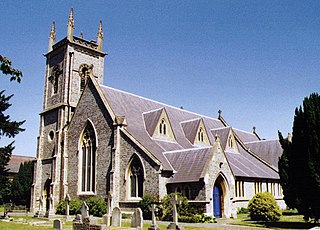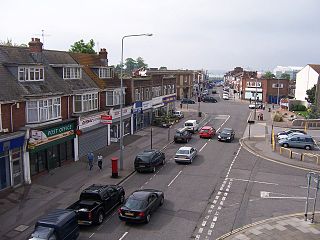
Earley is a town and civil parish in the Borough of Wokingham, Berkshire, England. Along with the neighbouring town of Woodley, the Office for National Statistics places Earley within the Reading/Wokingham Urban Area; for the purposes of local government it falls within the Borough of Wokingham, outside the area of Reading Borough Council. Its name is sometimes spelt Erleigh or Erlegh and consists of a number of smaller areas, including Maiden Erlegh and Lower Earley, and lies some 3 miles (5 km) south and east of the centre of Reading, and some 4 miles (6 km) northwest of Wokingham. It had a population of 32,036 at the 2011 Census.

Earl Waldegrave is a title in the Peerage of Great Britain. It was created in 1729 for James Waldegrave, 2nd Baron Waldegrave.

Netley, officially Netley Abbey, is a village on the south coast of Hampshire, England. It is situated to the south-east of the city of Southampton, and flanked on one side by the ruins of Netley Abbey and on the other by the Royal Victoria Country Park.

Waldegrave is the name of an English family, said to derive from Walgrave in Northamptonshire, who long held the manor of Smallbridge in Bures St. Mary, Suffolk.

Admiral William Waldegrave, 1st Baron Radstock, GCB was an officer in the Royal Navy and Governor of Newfoundland.
Weston is a small suburb on the south-eastern side of Southampton, UK, predominantly built on the Weston Grove Estate formerly owned by the Chamberlayne family. It also includes the area that was previously the Barnfield Estate. Weston includes part of Mayfield Park, which was previously the Mayfield Estate. Weston is bounded by Woolston, Sholing, Netley and Southampton Water.

North Baddesley is a large village and civil parish in Hampshire, England. It is situated 3 mi (5 km) east of the town of Romsey and 6 mi (10 km) north of Southampton. It occupies an area of approximately 9.15 km2 (3.53 sq mi), and is home to a population of just over 10,000 people, reducing to 7,000 at the 2011 Census. It is located in the Test Valley; a river famous for trout fishing.

Sholing, previously Scholing, is a district on the eastern side of the city of Southampton in Southern England. It is located between the districts of Bitterne, Thornhill and Woolston.

Woolston is a suburb of Southampton, Hampshire, located on the eastern bank of the River Itchen. It is bounded by the River Itchen, Sholing, Peartree Green, Itchen and Weston.
Weston Secondary School is a coeducational secondary school located in the Weston area of Southampton, in the English county of Hampshire.

Woolston School Language College was a secondary comprehensive school in Southampton, Hampshire, in southern England. The last Ofsted inspection was on 10 October 2006. The school was a Specialist Language College for students that were 11 to 16 years old. There were around 770 pupils enrolled in the school at the time of closure.

Weston Park Boys' School, subsequently renamed Grove Park Business and Enterprise College, was a comprehensive school in east Southampton, Hampshire, in the south of England. The school was closed in 2008 to make way for Oasis Academy Mayfield. The most recent Ofsted inspection was on 17 May 2004.

Granville Augustus William Waldegrave, 3rd Baron Radstock was a British missionary and a baron in the Peerage of Ireland.

Oasis Academy Mayfield is a city academy in Southampton, England, run by Oasis Community Learning with approximately 900 pupils.
Tankerville Chamberlayne was a landowner in Hampshire and a member of parliament, serving the Southampton constituency three times, as an Independent and Conservative. He was deprived of his seat after the 1895 general election because of the indiscretion of one of his campaign workers and his having headed a procession which raised suspicion of having supplied beer to supporters. He subsequently raised the question of false electioneering statements in Parliament.

Cranbury Park is a stately home and country estate situated in the parish of Hursley, Winchester, England. It was formerly the home to Sir Isaac Newton and later to the Chamberlayne family, whose descendants continue to own and occupy the house and surrounding park and farmland in the 21st century. The house and park are not generally open to the public, although open days are occasionally held.
Thomas Chamberlayne was an English first-class cricketer and yachtsman.
History of Woolston, suburb of Southampton, Hampshire.

Westwood Woodland Park is a 49.5-hectare (122-acre) Local Nature Reserve in Southampton in Hampshire. It is owned by Hampshire County Council and managed by Hampshire County Council and Southampton City Council. The site is split in two by a stream, the 'Tickleford Gully'. The park forms the boundary of Southampton and Netley.















